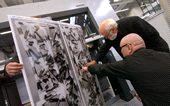Offset Printing
The Press as a Darkroom – Exhibition of Unique Photographs at the Print Media Academy in Heidelberg

Wednesday 08. July 2009 - Revolutionary process enables photos to be printed directly from the negative in a quality never previously seen; All exhibits of the exposition have been created by well-known photographers, and are printed on Heidelberg presses
High Definition Skia Photography (HDSP) is the name of the new, revolutionary printing process that delivers photo prints of unprecedented quality on conventional offset paper and reproduces even the finest textures and details. This new technology, which works directly from the negative – the skiagraphic image – produces photographs without the need for a darkroom.
To mark this breakthrough, the inventor of HSDP, Dieter Kirchner, and Heidelberger Druckmaschinen AG (Heidelberg) are organizing an exhibition of around 50 photographs at the Print Media Academy in Heidelberg from July 20-24, 2009. These will include contributions from notable photographers such as Dieter Appelt, Manfred Hamm, Ulrich Mack, and Jim Rakete – all of them produced using HDSP.
All the photos in the PMA exhibition were printed on Heidelberg presses. The necessary quality is achieved by ensuring the right interplay between press, software, and consumables – ink in particular.
Details
“We are delighted to be hosting this exhibition for all lovers of quality photography and, in so doing, are reinforcing our claim that Heidelberg solutions set the benchmark when it comes to print products representing the ultimate in high-end quality,” states Dr. Jürgen Rautert, Member of the Management Board responsible for Marketing, Sales, and Service at Heidelberg.
The exhibition at the Print Media Academy in Heidelberg runs from July 20-24 and is open from 9 a.m. to 5 p.m. Anyone who is interested in seeing the photos is welcome and entry is free of charge.
How does HDSP work?
In High Definition Skia Photography, negatives, slides or raw data are recorded in two different digital data sets. An electronic darkroom program uses this data to calculate all gamma curves that are of relevance to the developing process for printing purposes. Based on a defined digital image, the photographer adjusts the paper gradation as he previously did in the darkroom. Prints are produced using special inks adapted to the developer substances. This also turns the press into a darkroom, the key difference being that the printing process is reproducible. This printing technology is based on a new standardization process for uniform, optimized color separation and the design of the new Heidelberg presses. As a result, it is possible to print even short runs with barely perceptible fluctuations in tone.
Since conventional photo paper only has a limited image gamut, around a third of the optical image gamut is cut off. HDSP, on the other hand, exhibits an image gamut that lies at the limit of visual perception. For the first time, all visible components captured by the camera are transferred to the print. Given that the three-dimensional perception of paper prints depends on the image gamut and simultaneous contrast, an HDSP print achieves a high natural three-dimensionality.
